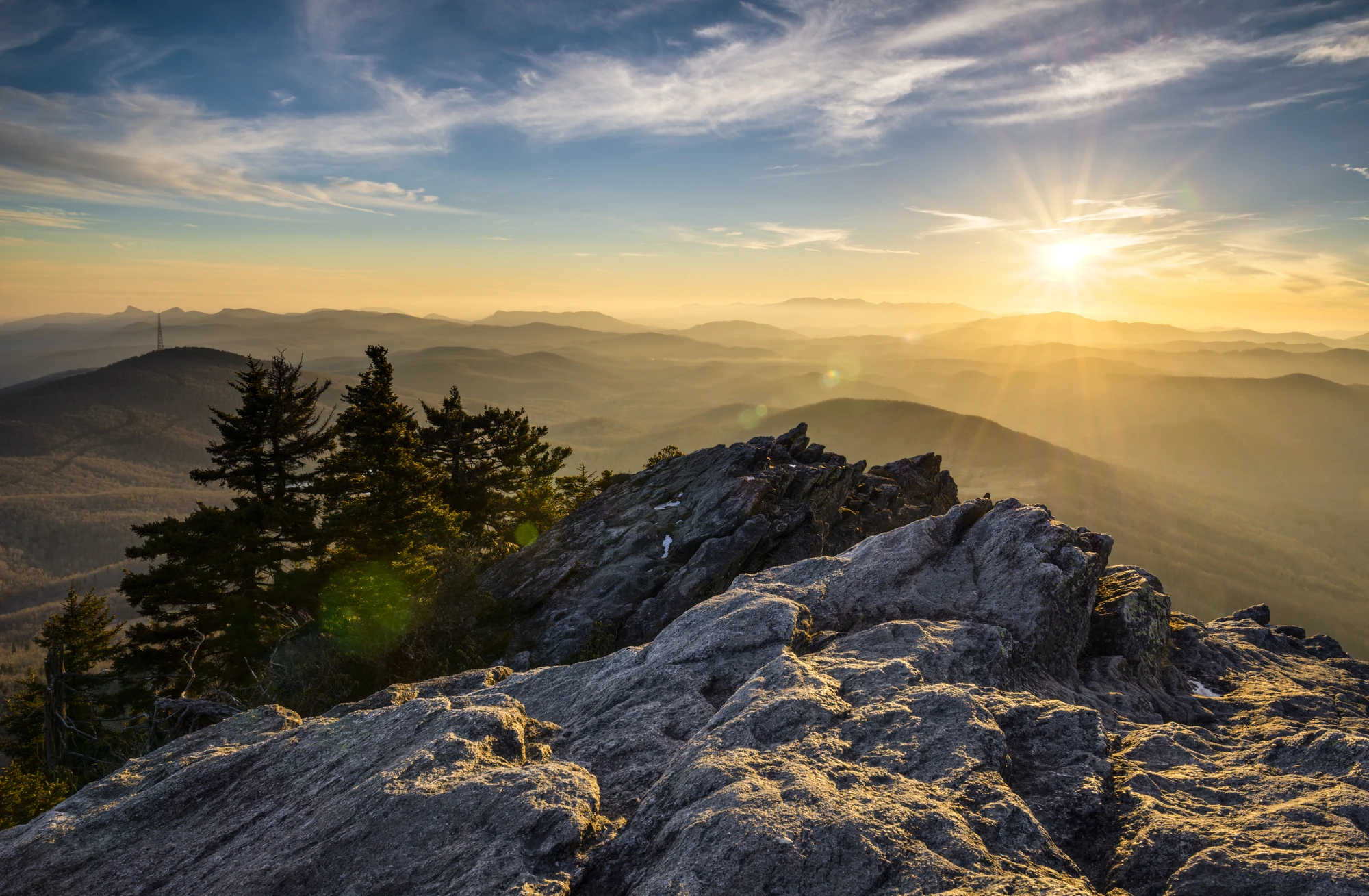Standing on the Ridge: Sunset and Scramble at Grandfather Mountain
A high-country guide to scrambling, wildlife, and the Mile High Swinging Bridge—what to know before you climb.
Photo by Unknown
Shutterstock (ID: 138721493)
The sun doesn’t so much set behind Grandfather Mountain as it negotiates the ridge—slipping its colors into the folds of rock and forest, then pausing, as if to see whether the mountain will agree to put on another display. From the parking area and winding park road, you hear the landscape long before you see it: wind through spruce and rhododendron, the distant scrape of hikers’ boots on stone, and the faint, breathy call of a bird riding the thermals above Calloway Peak. When you top one last rocky ramp and step onto the Mile High Swinging Bridge, the valley opens like a sealed letter. The moment compresses into a single, sharp feeling—the vertiginous joy of being at the top of the Blue Ridge.
Trail Wisdom
Start before dawn
Begin hikes early to avoid crowds and afternoon wind; summit sections are safer in calm morning conditions.
Footwear and traction
Wear sturdy hiking boots with good tread—expect wet slabs and exposed roots on steeper pitches.
Watch the weather
Carry a windproof shell and check forecasts; conditions at 5,900 ft can change rapidly compared with the valley.
Respect fragile habitat
Stay on designated trails—high-elevation bogs and dwarf spruce recover slowly from foot traffic.
Local Knowledge
Hidden Gems
- •The understory ledges south of the summit for quieter sunset views
- •Short detours to boggy dwarf spruce areas that host unique high-elevation plant communities
Wildlife
peregrine falcon, black bear
Conservation Note
Trail stewardship and visitation fees support habitat restoration and educational programs—stay on trails and consider donating or volunteering to help preserve the fragile high-country ecosystem.
Named for a rock profile early settlers thought resembled an old man, Grandfather Mountain has long been a landmark and now supports education and conservation through the Stewardship Foundation.
Seasonal Guide
spring
Best for: wildflower blooms, moderate temperatures, birdwatching
Challenges: muddy trails, late snow at high elevations
Spring brings fresh blooms and running streams, but lingering snow and muddy trail sections are common at higher elevations.
summer
Best for: long daylight, wildlife viewing, full access to facilities
Challenges: afternoon storms, higher visitation
Summer offers warm mornings and full facility hours but expect rapid afternoon thunderstorms and busy parking.
fall
Best for: peak foliage, crisp air, photography
Challenges: heavy weekend crowds, cooler nights
Fall is prime for color and clear air; plan for cold nights and book nearby lodging early on peak weekends.
winter
Best for: solitude, snowy panorama, off-season training
Challenges: road closures, ice on exposed sections
Winter delivers dramatic, quiet landscapes but can bring icy trails and limited access—check road and attraction closures before traveling.
Photographer's Notes
What to Bring
Sturdy hiking bootsEssential
Provide traction and ankle support on rocky, rooty, and sometimes wet terrain.
Windproof shellEssential
Protects against sudden high-elevation wind and light rain.
Hydration system (2 liters)Essential
Keeps you hydrated during steep climbs where water sources are unreliable.
Lightweight headlamp
Useful if your hike runs later than planned or for pre-dawn starts.
Common Questions
How high is Grandfather Mountain’s summit?
Calloway Peak, the mountain’s highest point, reaches approximately 5,946 feet above sea level.
Is the Mile High Swinging Bridge actually a mile high?
The bridge’s name is historic—the walkway sits near 5,280 feet in some sections of the attraction, though the peak is higher; exact elevation at the bridge varies by location across the summit ridge.
Are dogs allowed on the trails or bridge?
Policies vary—service animals are generally permitted, but pets may be restricted in certain attraction areas; check the Grandfather Mountain visitor guidelines before bringing pets.
Do I need a permit to hike the trails?
No special permit is required for day hiking, but the managed attraction charges an admission fee for visitor access to facilities and some summit road access—confirm current fees on the official site.
What's the best time of day to visit the summit?
Early morning offers calmer winds, clearer light, and fewer people—late afternoon brings dramatic sunsets but can mean strong winds and crowds.
Can I camp on Grandfather Mountain?
Backcountry camping is restricted; nearby state parks and national forest areas offer designated campsites—plan and reserve camping off the mountain as appropriate.
What to Pack
Sturdy boots (traction on rock), layered jacket (wind/sun protection), 2L water (hydration on climbs), trail snacks (energy for steep sections)
Did You Know
Calloway Peak, Grandfather Mountain’s highest point, reaches approximately 5,946 feet—making it one of the highest summits in the Blue Ridge Mountains.
Quick Travel Tips
Buy attraction tickets online to skip lines; check summit road and bridge status before arrival; plan for 20–30°F temperature drop from valley to summit; park early to secure a spot on busy days.
Local Flavor
Local high-country fare focuses on trout, Appalachian biscuits and gravy, and craft breweries in Boone and Blowing Rock; time a visit with the Grandfather Mountain Highland Games in July for music, heavy athletics, and community flavor.
Logistics Snapshot
Elevation: ~5,946 ft; Top access: park road and trailheads; Difficulty: challenging for summit routes; Facilities: visitor center, restrooms, interpretive exhibits; Fees: day admission to attraction may apply; Cell: intermittent—download maps.
Sustainability Note
Support the Grandfather Mountain Stewardship Foundation, stay on marked trails to protect rare alpine plants, and pack out all trash—high-elevation ecosystems are slow to recover from disturbance.

